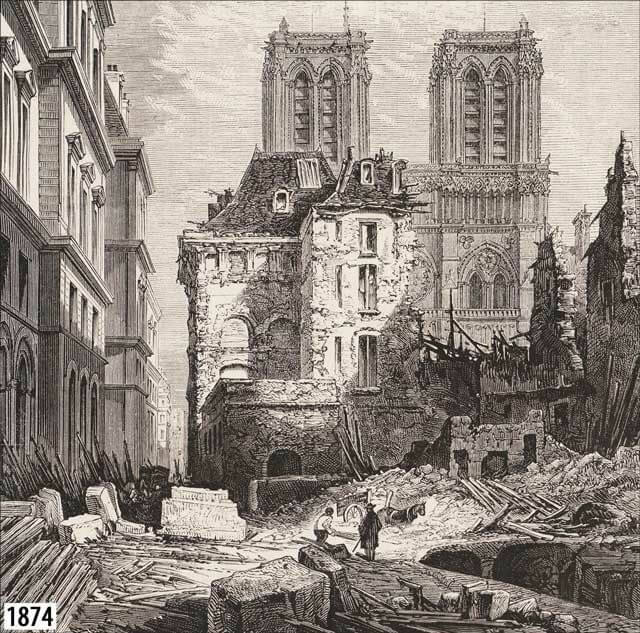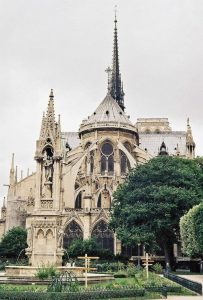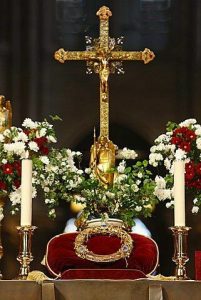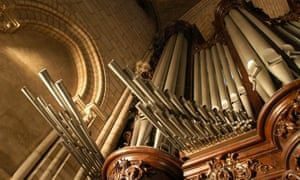The strong and resilient Lady of Paris not only survived the recent tragedy, the massive fire that engulfed her on 15th April’ 19, but she has stood tall for centuries after various turbulent and violent setbacks, says Monika, in the second part of her in-depth research. A Different Truths exclusive.
 The cathedral, which houses not only the “Crown of Thorns” rests on the Île de la Cité, an island in the center of the river Seine. Notre Dame was built at the place of a Gallo-Roman devoted to the god Jupiter. Much before that, it was supposedly a sacred site to Neolithic Britons.
The cathedral, which houses not only the “Crown of Thorns” rests on the Île de la Cité, an island in the center of the river Seine. Notre Dame was built at the place of a Gallo-Roman devoted to the god Jupiter. Much before that, it was supposedly a sacred site to Neolithic Britons.
The town was so intelligently developed and ideally placed that it grew wealthy with the passage and control of goods through the waterway. By the 10th century, Paris was the center of European power. In 1160, Bishop Maurice de Sully decided to build a shrine in the tradition of Gothic art. The first stone is believed to have been laid by Pope Alexander III in 1163.
The Enchanting Lady of Paris is among the most visited spots on earth. England’s King Henry VI was crowned King of France in the cathedral in 1431, and Napoleon I had his coronation as Emperor there in 1804. It was restored by architect Eugène Viollet-le-Duc in the 19th century. The cathedral’s central spire, which hit the debris in the recent fire, was added during this period.
Victor Hugo’s classic, The Hunchback of Notre Dame, in 1831, drew much attention to the poor condition of the cathedral, which in turn instigated the restoration work.
Victor Hugo’s classic, The Hunchback of Notre Dame, in 1831, drew much attention to the poor condition of the cathedral, which in turn instigated the restoration work.
The 850-year old Cathedral remains an exemplary marvel due to many reasons.
An elucidation.
1. La Foret / The Forest:
“The Forest” of wooden latticework inside Notre Dame Cathedral in recent tragedy fuelled the flames that devoured the iconic church. The wooden framework primarily made of oak contains beams that date as far back as the first frame built for the cathedral. Twenty-one hectares, that constituted almost 13000 oak trees from the nearby forest were cut down between 1160 AD and 1170 AD, forming one of the oldest parts of the structure.
“The Forest” of wooden latticework inside Notre Dame Cathedral in recent tragedy fuelled the flames that devoured the iconic church. The wooden framework primarily made of oak contains beams that date as far back as the first frame built for the cathedral.
To reach the desired height, the carpenters needed to build the structure and the trees are believed to have been 300 or 400 years old, meaning they would have sprouted out of the ground in the eighth or ninth centuries.
According to Notre Dame’s official website, the beams constitute one of the oldest structures in Paris. The dimensions of the framework are gigantic, 100 meters long and 10 meters high. At the nave of the church, the frame is almost 13 meters wide, and at the transept it’s 10 meters high. The wooden framework supported a roof, made of lead, that weighed 210 tons. Unfortunately, the fire once again led this Lady, open to the sky.
2. The Flying Buttresses
Ravy, Jean. An ingenious French architect who worked for Notre-Dame Cathedral from 1318-1344, actuated the iconic flying buttresses. exterior braces that uphold the building while letting the interior walls stay visually clear of support structures, according to National Geographic. On the cathedral’s east end, the single-arch flying buttresses are “especially notable for their boldness and grace.” Hence Notre Dame Cathedral became the pioneer in incorporating the use of this sophisticated yet strong structure.
An ingenious French architect who worked for Notre-Dame Cathedral from 1318-1344, actuated the iconic flying buttresses. exterior braces that uphold the building while letting the interior walls stay visually clear of support structures, according to National Geographic.
A structural support network, an integral feature of Gothic architecture along with with with the arch, the ribbed vault. Notre Dame was one of the first to incorporate this structure. The framework enabled to hold up very tall but comparatively thin stone walls, so that much of the wall space could be filled with stained-glass windows. The flying buttresses, common in medieval churches and cathedrals works as stability feature, balancing the pressures. Another very significant reason flying buttresses were used in the Notre Dame Cathedral was to allow adequate light inside. The high walls and lack of windows the cathedral proved to be quite dark. Later architects envisaged that with the addition of more flying buttresses can incorporate large stained-glass windows along the walls of the cathedral to allow in more light.
The old buttresses, however, were replaced in the 14th century. Since the Gothic was no more in style, the Renaissance (14- 17th century) style was adopted.
The old buttresses, however, were replaced in the 14th century. Since the Gothic was no more in style, the Renaissance (14- 17th century) style was adopted. The gothic pillars were covered with tapestries. The sanctuary was rearranged, and the choir was rebuilt with marble.
3. The “Crown of Thorns”
The inferno that raged through the Cathedral for almost 15 hours destroyed its spire and its oak-roof but fortunately spared its most precious treasures, including the “Crown of Thorns” allegedly worn by Jesus on his crucifixion. According to three of the Gospels, a woven crown of thorns was fixed on the head of Jesus during the event. It was one of the contrivances, employed by Jesus’ incarcerators to cause him pain.
The inferno that raged through the Cathedral for almost 15 hours destroyed its spire and its oak-roof but fortunately spared its most precious treasures, including the “Crown of Thorns” allegedly worn by Jesus on his crucifixion.
The crown was obtained and brought to Paris in the 13th century by King Louis IX, who was later canonized as Saint Louis. Along with the crown, “The Tunic of St. Louis”, the centuries-old garment that was purported to have belonged to King Louis IX, was also rescued.
The cathedral’s Altar and Golden Cross too survived the frantic fire.
4. The Spire and the Statues
The famous spire and the statues pursue their origin to the mid-19th century. The original spire had been removed in the late 18th century after the natural wear and tear. But before on the brink of collapsing, the structure was removed.
The famous young architect Eugène Emmanuel Viollet-le-Duc in 1844 was commissioned to lead the restoration work. The spire, which was actually made of wood and covered with a protective sheath of the lead coating was wrecked in a fire.
The famous young architect Eugène Emmanuel Viollet-le-Duc in 1844 was commissioned to lead the restoration work.
The spire, which was actually made of wood and covered with a protective sheath of the lead coating was wrecked in a fire. Viollet-le-Duc’s designed spire product was a massive installation in the Parisian sky, a religious light-tower that in French is called “la fléche,” meaning arrow.
At the spire’s base were the 12 apostles and the four Gospelers — the winged man, lion, ox, and eagle symbolising religious faith. Another statue, the lone Saint Thomas, one of the apostles faced the spire.
All these religious statues are believed to survive the recent tragedy.
5. Bells and organs
The destruction caused by the French Revolution left the deepest scars on the Grand Lady. Crowd looted and beheaded various statues. Bells that rung from the cathedral’s towers were melted down into cannons.
The destruction caused by the French Revolution left the deepest scars on the Grand Lady. Crowd looted and beheaded various statues. Bells that rung from the cathedral’s towers were melted down into cannons.
Cathedral Bells remain undoubtedly one of the most remarkable artifacts. There are ten bells associated with the cathedral Notre-Dame. Each has its own name and is used for important. Emmanuel Bell, a massive bourdon bell has survived several catastrophes This bell dates back as far as the 15th century but was actually recast by orders of King Louis XIV in 1681.
Four that had been destroyed for making cannons were replaced and restored in mid-19th-century. Yet, a famous event in Cathedral’s history came on August 24, 1944, when it rang its bells to celebrate the liberation of Paris from German occupation after the end of World War II.
Also surviving was the Roman Catholic Cathedral’s famous 18th-century organ that boasts more than 8,000 pipes.
Also surviving was the Roman Catholic Cathedral’s famous 18th-century organ that boasts more than 8,000 pipes. The eye-catching organ is unquestionably an imposing instrument, towering over the hall, almost 53 ft. above the ground. Apart from 8k pipes, it showcases five keyboards, 109 stops, and pedals.
The instrument is one of the greatest in France and undoubtedly one of the most famous in the world.
References
- The Story of Buildings by Patrick Dillon
- Wikipedia – Notre Dame
3. An 800-year history Notre Dame – National Geographic
4. Wikipedia – Relics associated with Jesus.Bibliography
1. Gallo-Roman: The term “Gallo-Roman” describes the Romanised culture of Gaul under the rule of the Roman Empire.
2. Coronation: the ceremony of crowning a sovereign or a sovereign’s consort.
3. Altar: the table in a Christian church at which the bread and wine are consecrated (declared sacred) in communion services.
(To be continued)
Photos sourced by the author from the Internet










 By
By

 By
By